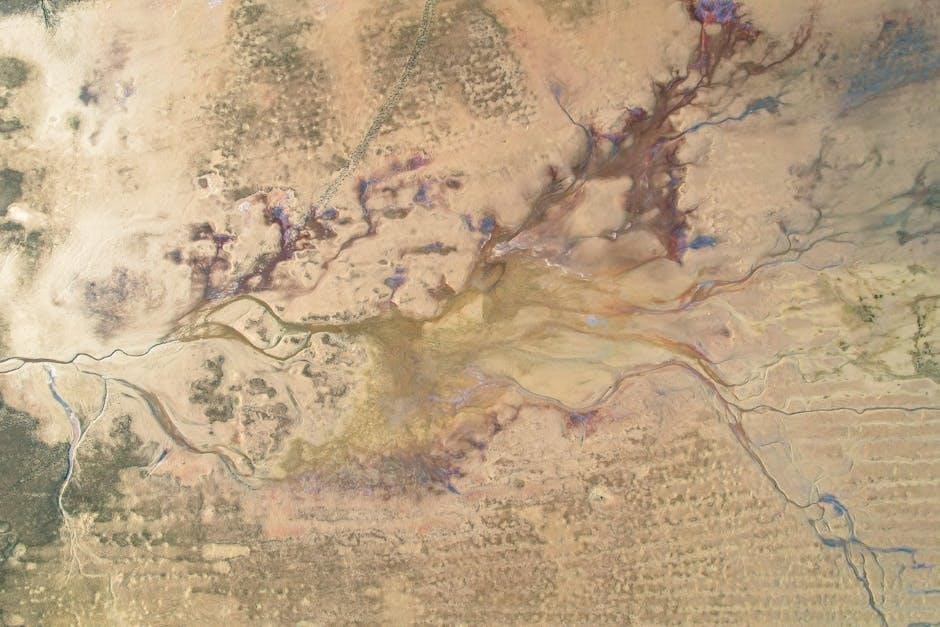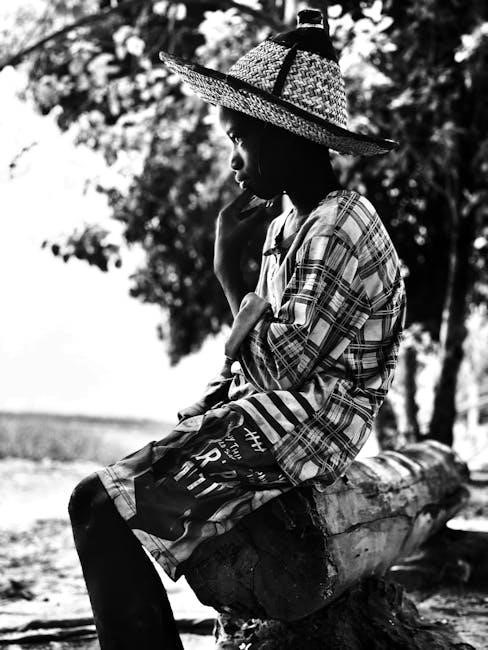Global patterns of linkage disequilibrium (LD) at the CD4 locus reveal insights into human genetic diversity, population structure, and evolutionary history, particularly supporting a common African origin.
1.1 Background and Significance
Linkage disequilibrium (LD) refers to the non-random association of alleles at different loci, providing insights into population history and genetic diversity. The CD4 locus, located on chromosome 12, has been extensively studied for its role in the immune system and its genetic variation. Global patterns of LD at this locus reveal significant correlations with population migration and evolutionary processes. Studies, such as those by Tishkoff et al., highlight how LD at the CD4 locus supports a common African origin for modern humans. These findings underscore the importance of LD in tracing ancestral migration routes and understanding human evolutionary dynamics. The CD4 locus serves as a valuable marker for exploring genetic diversity and population structure worldwide.
1.2 Importance of the CD4 Locus in Human Genetics
The CD4 locus, located on chromosome 12, plays a crucial role in the human immune system by encoding the CD4 protein, essential for T-cell function and immune response. Its genetic variation and linkage disequilibrium patterns have been instrumental in tracing human migration and evolutionary history. The locus is tightly linked, with markers showing strong LD, making it a valuable marker for population genetic studies. Research by Tishkoff et al. demonstrated that LD at the CD4 locus supports a recent African origin for non-African populations, highlighting its significance in understanding human genetic diversity and ancestral origins. This makes the CD4 locus a key region for studying both immune function and human evolutionary history.
1.3 Objectives of Studying Linkage Disequilibrium (LD)
Studying linkage disequilibrium (LD) at the CD4 locus aims to uncover the genetic basis of traits and diseases by identifying non-random associations of alleles. A key objective is to map genes associated with immune-related diseases, leveraging LD patterns to pinpoint causal variants. Additionally, LD analysis at the CD4 locus helps trace population histories, migration routes, and evolutionary dynamics. By examining global LD patterns, researchers can infer ancestry and population structure, shedding light on human migration and diversification. Furthermore, LD studies at this locus provide insights into how genetic diversity has been shaped by demographic factors, such as population size, migration, and selection. These objectives collectively contribute to a deeper understanding of human genetics, evolution, and disease susceptibility.

The CD4 Locus: Structure and Function
The CD4 locus, located on chromosome 12, encodes a gene essential for immune cell function, particularly in T-cell receptor signaling, playing a critical role in the immune system.
2.1 Genomic Location and Organization
The CD4 locus is located on the short arm of chromosome 12 in humans, spanning approximately 45 kilobases. It consists of 13 exons, with the majority encoding the CD4 protein, which is crucial for immune cell function. The gene is surrounded by regulatory elements that control its expression in T-cells. Notably, the locus includes non-coding regions where tightly linked markers have been identified, such as those studied for linkage disequilibrium. These markers, located approximately 9.8 kilobases apart, are significant for understanding haplotype variation and population genetics. The organization of the CD4 locus reflects its evolutionary importance, with conserved regions suggesting functional significance across populations.
2.2 Role of the CD4 Gene in the Immune System
The CD4 gene, located on chromosome 12, encodes the CD4 protein, a crucial component of the immune system. Primarily expressed on T-helper cells, CD4 facilitates the recognition of antigen-presenting cells by binding to MHC class II molecules. This interaction is essential for T-cell activation, enabling the coordination of immune responses, including B-cell activation and cytotoxic T-cell function. Dysregulation or mutations in the CD4 gene can impair immune function, leading to increased susceptibility to infections. Additionally, the CD4 protein is a primary target for HIV, which infects and depletes T-helper cells, severely compromising the immune system. The CD4 gene’s role in immune regulation underscores its significance in maintaining immune homeostasis and its implications in understanding immune-related diseases and genetic predispositions.
2.3 Polymorphisms and Variants at the CD4 Locus
The CD4 locus exhibits a range of polymorphisms, including single nucleotide polymorphisms (SNPs) and insertion/deletion variants, which contribute to genetic diversity. These variations are found in both coding and non-coding regions, with some affecting CD4 expression or function. Certain polymorphisms, such as the CD4 C/T SNP at position -262, have been associated with differences in CD4 expression levels, potentially influencing immune response variability. These genetic variations are also critical for understanding linkage disequilibrium patterns, as they form distinct haplotypes that vary across populations. The distribution of these polymorphisms provides insights into population history, with specific haplotypes being more prevalent in certain geographic regions. Such genetic diversity underscores the importance of the CD4 locus in studies of human evolution and disease susceptibility.
Linkage Disequilibrium: Concepts and Definitions
Linkage disequilibrium (LD) refers to the non-random association of alleles at different loci, influencing genetic diversity and disease mapping. It is shaped by population history and genetic structure.
3.1 Definition and Mechanisms of Linkage Disequilibrium
Linkage disequilibrium (LD) refers to the non-random association of alleles at different loci, often resulting from population history, mutation, or selection. At the CD4 locus, LD arises when specific alleles are inherited together more frequently than expected by chance. This phenomenon is influenced by factors such as genetic drift, migration, and recombination rates. The mechanisms driving LD involve the interaction of genetic and demographic forces, shaping allele frequencies and haplotype structures across populations. Understanding LD is crucial for mapping genes, studying evolutionary processes, and interpreting genetic variation. The CD4 locus, in particular, has been studied extensively to uncover patterns of LD that reflect human migration and population dynamics, providing insights into modern human origins and genetic diversity.
3.2 Factors Influencing Linkage Disequilibrium
Linkage disequilibrium (LD) at the CD4 locus is shaped by several factors, including population history, genetic drift, mutation rates, and recombination. Population structure, such as migration and admixture, significantly impacts LD patterns. Natural selection also plays a role, favoring certain haplotypes that confer adaptive advantages. Additionally, demographic events like bottlenecks or expansions can alter LD by changing allele frequencies. The physical distance between loci influences recombination rates, which in turn affect LD decay. These factors interact intricately, creating distinct LD patterns observed globally, particularly at the CD4 locus, where studies highlight its relevance in understanding human evolutionary dynamics and genetic diversity across populations.
3.3 Linkage Disequilibrium vs. Linkage: Key Differences
Linkage disequilibrium (LD) and linkage are distinct concepts in genetics. Linkage refers to the physical proximity of genes on a chromosome, causing them to be inherited together. In contrast, LD describes the non-random association of alleles at different loci in a population. While linkage is a chromosomal phenomenon, LD arises from population-level events like migration, selection, and drift. LD can exist between unlinked loci due to demographic factors, whereas linkage is solely due to physical proximity. Understanding these differences is crucial for interpreting genetic data, particularly at loci like CD4, where LD patterns reveal evolutionary histories and population dynamics.

Global Patterns of Linkage Disequilibrium at the CD4 Locus
Global patterns of linkage disequilibrium at the CD4 locus reveal significant haplotype variations, supporting a common African origin and reflecting ancient migration routes and population dynamics.
4.1 Description of Haplotype Variation
Haplotype variation at the CD4 locus exhibits distinct patterns globally, with specific allelic combinations prevalent in different populations. These variations are shaped by genetic drift, selection, and demographic history.
4.2 Geographic Patterns of LD Across Populations
Geographic patterns of linkage disequilibrium (LD) at the CD4 locus show significant variation across populations. African populations exhibit lower LD due to higher genetic diversity and larger effective population sizes, while non-African populations display higher LD, consistent with a bottleneck effect during the Out-of-Africa migration. This pattern supports the hypothesis of a recent common African origin for all modern humans. Such geographic differences in LD provide valuable insights into human migration routes and demographic history, highlighting the role of genetic structure in shaping population-specific LD patterns globally.

4.3 Decay of Linkage Disequilibrium with Physical Distance
Linkage disequilibrium (LD) at the CD4 locus decays progressively with increasing physical distance between markers. This decay is influenced by recombination events, genetic drift, and population history. In African populations, where genetic diversity is higher, LD decays more rapidly due to larger effective population sizes and longer histories of recombination. In contrast, non-African populations exhibit slower LD decay, reflecting bottlenecks during migration and founding events. This pattern underscores the impact of demographic factors on LD structure and highlights how physical distance interacts with population history to shape genetic variation. The rate of LD decay provides critical insights into the evolutionary forces shaping the CD4 locus across global populations.

Linkage Disequilibrium and Modern Human Origins
Global LD patterns at the CD4 locus provide strong evidence for modern human origins, supporting a common African ancestry and insights into migration routes of early humans.
5.1 Evidence for a Common African Origin
Studies of global patterns of linkage disequilibrium (LD) at the CD4 locus provide compelling evidence for a common African origin of modern humans. Haplotype variation and LD patterns across global populations reveal a recent African ancestry, with reduced genetic diversity observed in non-African populations. This suggests that early humans migrated out of Africa, carrying specific haplotypes that are now prevalent in non-African groups. The tight linkage of markers at the CD4 locus further supports this model, as the preservation of haplotypes across vast geographic distances indicates a shared ancestral origin. These findings align with the “Out of Africa” hypothesis, highlighting the critical role of Africa in shaping human genetic diversity and migration patterns.
5.2 Migration Routes and Population Dynamics
Linkage disequilibrium (LD) patterns at the CD4 locus illuminate historical migration routes and population dynamics. These patterns suggest that early humans migrated from Africa, with subsequent movements shaping genetic diversity across regions. For instance, the spread of specific haplotypes across Eurasia and the Pacific correlates with known migration events. Population dynamics, such as expansions and bottlenecks, have influenced LD levels, with smaller populations exhibiting higher LD due to genetic drift. Additionally, admixture between populations has modified LD structures, reflecting complex demographic histories. These insights highlight how genetic data can trace human migration and population interactions, offering a genetic map of our ancestral journeys.
5.3 Implications for Human Evolution and Diversity
The study of linkage disequilibrium (LD) at the CD4 locus provides critical insights into human evolution and diversity. The observed patterns of haplotype variation and LD strongly support the “Out of Africa” model, indicating a recent common ancestry for all modern humans. These findings highlight the role of migration, genetic drift, and selection in shaping human genetic diversity. The data also reveal how population dynamics, such as bottlenecks and expansions, have influenced the distribution of genetic variants. Furthermore, the analysis of LD at the CD4 locus underscores the importance of Africa as the source of genetic diversity for all human populations. These insights contribute significantly to our understanding of human evolutionary history and the genetic basis of population differences.

Demographic Factors Shaping Linkage Disequilibrium
Population dynamics significantly influence LD patterns. Factors such as population size, migration, bottlenecks, and genetic drift shape the structure and diversity of LD at the CD4 locus.
6.1 Effects of Population Size and Structure
Population size and structure significantly impact linkage disequilibrium (LD) patterns. Smaller populations tend to exhibit higher LD due to genetic drift, while larger populations maintain more haplotype diversity. Bottlenecks and founder effects can inflate LD by reducing genetic variation. Conversely, population growth and migration can disrupt LD by introducing new alleles. Geographic structure also plays a role, as isolated populations may develop distinct LD patterns. For example, African populations, with larger effective sizes, show lower LD compared to non-African populations, which experienced bottlenecks during migration. These demographic factors shape the decay of LD over time, influencing the genetic landscape of the CD4 locus across global populations.
6.2 Role of Migration and Admixture
Migration and admixture play pivotal roles in shaping global patterns of linkage disequilibrium (LD) at the CD4 locus. Population movements transfer haplotypes across regions, altering LD structures. Admixture introduces new genetic variants, disrupting existing LD patterns. For instance, non-African populations exhibit reduced LD due to bottlenecks during migration, while African populations retain higher haplotype diversity. Studies reveal that LD patterns at the CD4 locus support a common African origin, with subsequent migrations spreading haplotypes globally. Admixture events in regions like Europe and Asia further shaped LD by introducing new alleles. These dynamics highlight how migration and genetic exchange influence LD, offering insights into human evolutionary history and genetic diversity. Such patterns underscore the importance of considering demographic processes in LD studies.
6.3 Impact of Natural Selection and Genetic Drift
Natural selection and genetic drift significantly influence linkage disequilibrium (LD) patterns at the CD4 locus. Natural selection can favor specific haplotypes, altering allele frequencies and LD structures. Genetic drift, particularly in smaller populations, introduces random fluctuations in allele frequencies, disrupting LD. These forces are evident in global LD patterns, where selection pressures and demographic stochasticity shape haplotype diversity. For example, African populations exhibit higher haplotype diversity due to larger population sizes, while non-African populations show reduced diversity, likely due to bottlenecks and drift. These mechanisms highlight how evolutionary forces dynamically shape LD at the CD4 locus, providing insights into human genetic history and adaptation. Understanding their impact is crucial for interpreting global LD patterns and their implications for human genetics.
Haplotype Variation and Linkage Disequilibrium
Haplotype variation and LD at the CD4 locus reveal genetic diversity, with patterns shaped by evolutionary forces, providing insights into human population history and genomic structure.
7.1 Types of Haplotypes at the CD4 Locus
At the CD4 locus, haplotypes are classified based on specific allele combinations. These include common haplotypes associated with African populations, showing high diversity, and derived haplotypes found in non-African populations, indicating migration and bottlenecks. Rare haplotypes are also observed, often linked to genetic drift or recent mutations. These haplotype types reflect evolutionary events and population dynamics, providing a genetic record of human origins and migrations. The distribution of these haplotypes across global populations highlights the impact of demographic factors on genetic variation. Understanding haplotype types at the CD4 locus is key to tracing ancestry and mapping genetic diversity.

7.2 Inference of Ancestry from Haplotype Data
Haplotype data at the CD4 locus provides critical insights into ancestral origins. The distribution of haplotypes across populations reflects historical migration patterns and genetic continuity. African populations exhibit higher haplotype diversity, consistent with a common African origin, while non-African populations show reduced diversity due to bottlenecks during migration. Linkage disequilibrium patterns further refine ancestry inference by identifying shared genetic segments. Geographic-specific haplotypes allow researchers to trace population movements and admixture events. This approach has been instrumental in reconstructing human evolutionary history, supporting the “Out of Africa” model. By analyzing haplotype frequencies and LD, scientists can infer ancestry with precision, linking modern populations to their ancestral roots. These methods are invaluable for studying demographic history and genetic diversity.
7.3 Relationship Between Haplotype Diversity and LD
Haplotype diversity and linkage disequilibrium (LD) are closely interconnected. Higher haplotype diversity typically correlates with lower LD, as diverse haplotypes reduce the likelihood of strong associations between alleles. Conversely, regions with low haplotype diversity often exhibit higher LD due to fewer recombinatorial events breaking down allele associations. At the CD4 locus, African populations show higher haplotype diversity and lower LD compared to non-African populations, reflecting their deeper evolutionary history. This pattern highlights how demographic factors like population bottlenecks and migrations influence both haplotype diversity and LD. Understanding this relationship provides insights into population history and genetic structure, offering a framework for mapping disease-associated variants and studying evolutionary processes.

Implications of Linkage Disequilibrium Studies
Linkage disequilibrium studies reveal evolutionary patterns, aid in disease mapping, and provide insights into human migration and origins, offering valuable applications in genetics and anthropology.

8.1 Evolutionary Insights from LD Patterns
Linkage disequilibrium (LD) patterns at the CD4 locus provide critical evolutionary insights, revealing a common African origin for modern humans. Haplotype variation and LD decay with physical distance suggest recent migration events from Africa, shaping global genetic diversity. These patterns align with demographic models, emphasizing the role of population structure and migration in shaping LD. The data supports a single origin of non-African populations, with LD reflecting ancestral relationships and historical population dynamics. Such findings are instrumental in reconstructing human evolutionary history and understanding the genetic legacy of ancient migrations.
8.2 Applications in Medical Genetics and Disease Mapping

Understanding global patterns of linkage disequilibrium (LD) at the CD4 locus has significant applications in medical genetics and disease mapping. LD patterns help identify genetic variants associated with diseases, enabling fine-mapping of causal alleles. This is particularly relevant for immune-related disorders, as the CD4 gene plays a critical role in the immune system. By analyzing LD, researchers can pinpoint regions of the genome linked to disease susceptibility, enhancing the accuracy of genetic association studies. Additionally, LD data informs personalized medicine by identifying population-specific genetic risk factors. These insights are invaluable for developing targeted therapies and understanding the genetic basis of complex diseases, ultimately advancing precision medicine and public health initiatives.
8.3 Anthropological Relevance of LD Studies
Linkage disequilibrium (LD) studies at the CD4 locus hold profound anthropological significance, offering insights into human migration, population structure, and evolutionary dynamics. The global patterns of LD provide evidence for a common African origin of modern humans, as inferred from haplotype variation and LD decay. These studies trace ancient migration routes and population expansions, shedding light on how genetic diversity was shaped by demographic events. The analysis of LD across populations also reveals historical admixture and isolation, which are critical for understanding human ancestry. By examining LD, researchers can reconstruct ancestral relationships and infer past population interactions, making LD studies a powerful tool for unraveling the complexities of human history and diversity on a global scale.
Global LD patterns at the CD4 locus provide evolutionary insights, supporting a common African origin. Future studies should explore additional loci and populations to refine these findings.
9.1 Summary of Key Findings
The study of global patterns of linkage disequilibrium (LD) at the CD4 locus has provided critical insights into human evolutionary history. The analysis of haplotype variation and LD across populations strongly supports a common African origin for modern humans. These patterns reveal significant geographic structure, with African populations exhibiting higher genetic diversity and non-African populations showing a reduction in haplotype diversity, consistent with a recent out-of-Africa migration. Additionally, the decay of LD with physical distance and the influence of demographic factors such as population size, migration, and admixture have been well-documented. These findings not only advance our understanding of human evolution but also have implications for medical genetics and disease mapping, highlighting the importance of considering population-specific LD patterns in association studies.





